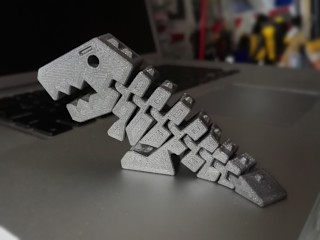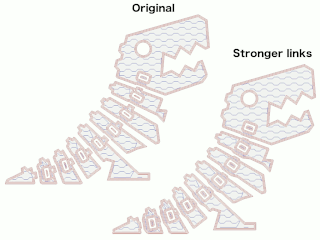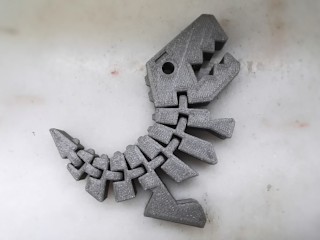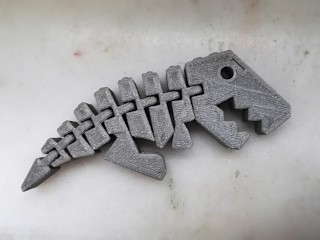3D printable print-in-place flexible T-rex, with strong links to be more kid-proof (formerly thing:2738211)
Creative Commons - Attribution - Share Alike
This is another remix of Kirbs' Flexi Rex (Thingiverse thing:1759297), based on airfish's remix (Thingiverse thing:2189652). That model in turn was most likely inspired by the ‘Flexy Rex’ by zheng3 (Thingiverse thing:929413).
This is the Flexi Rex, which now seems to have joined the club of things anyone having bought a 3D printer ought to print at least once. This is not the first version of this dinosaur. All credit for the original design and appearance goes to Kirbs. (Full history of this model can be found below.) My print of Kirbs' model was not very kid-proof however: one of the links broke after some rough handling. Hence in this updated version I made all links more robust. This means this model can probably be printed even smaller than the original ones before the links become too weak. Of course you can also scale it up at will.
The latest version of this model also has some tweaks that make it more balanced.
‘Dual’ files are also available if you have a multi-material printer and want to do a dual material print with alternating colors.
If you want to make a really huge print, there is an alternative version where you can print each segment separately and then assemble it. This also allows to print the model in multiple colors on single-material printers, but you do lose the magic of a fully assembled model coming straight out of the printer.
If you want to create your own flexible model, make sure to check the Hinge Design section below.
Read this, and you'll see that you probably have no need to contact me at all.
-
Q: “I want to sell prints of this model, do I need your explicit permission?”
A: No, but you must provide attribution, which means put a clearly visible link to this GitHub page on both your web store page and on a piece of paper included with printed objects. See below for instructions. -
Q: “Do I need to share profits if I sell this?”
A: No. All you need to do is provide the attribution as explained below. You're free to donate to show gratitude, but it is not required. -
Q: “I want to sell this but I don't want to do the attribution thing, can I bypass it by offering to share profits after all?”
A: No. Just provide the attribution, there is nothing difficult about it. -
Q: “Can I give away prints of this model?”
A: Yes, but you also need to provide attribution on a piece of paper included with each printed object. -
Q: “Can I use this model in a video or photo on a website for demonstration purposes?”
A: Yes, if you provide attribution, by linking to this GitHub page on the webpage where the video or photo is hosted. -
Q: “Can I modify this model and sell the modified model or prints of it?”
A: Yes, but you must provide (guess what) attribution, and also make your modified model available under the same Creative Commons BY-SA license, or a compatible license. -
Q: “So, I can start selling prints of this model without even having to spend time on figuring out how to contact the author?”
A: Yes indeed, thanks to the CC-BY-SA license under which it is released, at the condition that you comply with the conditions explained below. -
Q: “I found a remix of the Flexi Rex that has a mere Attribution or even Public Domain license, can I rely on those to bypass the whole CC BY-SA licensing thing?”
A: No. The reason why there are so many remixes with licenses that violate the BY-SA conditions, is that websites like Thingiverse and Printables make it way too easy to ‘whitewash’ a model's license when remixing it. The BY-SA license clearly states that each derivative must also have a BY-SA or compatible license. Hence the actual license you see assigned to a remix is actually irrelevant and is by definition BY-SA because that is the license of Kirbs' original model. This kind of reasoning would likely also be followed in case there is ever a legal dispute, so don't gamble on dodgy loopholes like these. -
Q: “Can I buy the exclusive copyright on this model?”
A: Hell no. This model is for the 3D printing community and it will stay that way. You might as well ask Linus Torvalds for the copyright on the Linux kernel.
This model is released under a Creative Commons - Attribution - Share Alike license. The details can be found on the CC website but in a nutshell, my interpretation of this license is that you are pretty much free to do anything with this model including selling prints if you comply with the following conditions:
- ‘Attribution’ means you must always provide a clearly visible reference to the source of the model, both on the webpage where you sell or display the model, and on a piece of paper included with each physical product. This is a very easy requirement that does not incur any significant extra cost. Here is an example of a full attribution message:
“Flexi Rex with stronger links by DrLex on GitHub, released under a Creative Commons Attribution - Share Alike license, based on Flexi Rex by Kirbs.”
For the required attribution message on your website/store, simply copy the above line, ensure the hyperlink to this GitHub page is preserved (or re-add it), and you're done.
If you are somehow tight on space, the most minimal attribution could be a hyperlink “print3D-FlexiRex by DrLex0 on GitHub - CC BY-SA” leading to this GitHub repository, but the full format shown above is preferred. If there really is no way to provide hyperlinks, the above line of text suffices because it contains enough information for people to find this source page, but you must provide links when possible.
When showing the model or prints of it in photos or in a video, the attribution message must at least be included as a text overlay or in the video's end credits. Optionally, the text with link can also be placed on the webpage that contains the photo/video.
The attribution message must not be hidden by silly tricks such as an unreadable font or putting a lot of whitespace before it.
As for paper print-outs to be included with physical sold prints, put a similar message on a piece of paper. Print it, write it, 3D print it, I don't care as long as it's there. Simplest is to use the ready-to-print attribution cards in PDF format that can be found in this repository. - ‘Share Alike’ means that if you make modifications to the 3D model and sell or give away physical representations of that modified model, either 3D printed or manufactured through other means, you must publish this modified 3D model and/or the source files for the other production method, and it must be licensed under the same CC BY-SA license or a compatible license. Of course wherever you publish or sell your modified model, there must also be a visible link back to the origin (i.e., this page). Again, this costs you nothing except a few minutes of your time.
Yes indeed, this makes it hard to commercialize any product based on this model, but that is the whole point of an open source license like this.
I may allow deviating from the strict SA requirements and also allow a remix to be published under a more restrictive license (for instance BY-ND or BY-NC-ND), if the remix differs sufficiently from the original and is tailored to a specific situation; contact me if you are unsure about this.
As you can see:
- There is no requirement to ask and obtain my explicit approval if you simply follow the conditions of the license. Feel free to drop me a message to notify me that you'll be selling or displaying this model somewhere, but it is not required if you comply with the license.
- There is no need to share profits. Of course you can always tip me if you insist on sharing some profits or just want to show some appreciation.
Notice to anyone buying prints of this model: it contains about 70 cents worth of material when printed in a premium filament. Add to this the costs of electricity and perhaps depreciation of printing infrastructure, and a bit of profit margin, and you might end up with about $2. Anyone who pays much more than that for a print is being ripped off.
If you see this model or prints of it being sold somewhere without the required attribution, don't try to contact me right away. I do not have the time or means to hunt down all unscrupulous people who want to make it seem as if they created this model and sell it at an exaggerated price. Also don't try to report it as a copyright violation yourself, this usually has to be done by the author of the work themself. It would be most helpful if you would first notify the author of the sales page and point them to this GitHub page. Ask them to add the required attribution. If they do not seem to care, you can go a step further and tell them you will contact the author. If that still doesn't help, then you may actually start contacting me (create an issue on GitHub, or use the contact page on my site).
Also note that selling the STL file for money is perfectly legal. It would be kind of dumb, but is allowed if proper attribution is provided on the page where the model is sold. The attribution would of course require to provide a clearly visible link to this page which provides the same download for free, making it obvious that the seller is a prick, but being a prick is not prohibited by the license.
Well, as explained above, anyone can sell direct or derived copies of this model, but they must comply with the CC BY-SA license. This means they would need make their modified 3D model publicly available, and arguably also the design of their injection molds, under the same CC BY-SA or compatible license. They also need to provide attribution.
At the time of this writing, it seems they have done neither. This is at another level than an Etsy shop selling 3D prints without attribution, and obviously it sucks. We can be pretty sure that a company having spent a considerable investment on making injection molds, which is mighty expensive and time-consuming, will not easily want to abide by the conditions of a CC-BY license, out of some kind of fear that it might reduce their profits—even though it probably won't.
I'm calling out to the whole 3D printing community here: there are a few things we can do.
- First of all, don't link to them anywhere, don't mention their name. There is no such thing as negative publicity, so the best we can do is no publicity at all. If you want to make a video about this on social media, blur product and shop names and URLs.
- If you know someone who considers buying this clone and you have a 3D printer, offer them 4 Flexi Rexes in any color they like. It will still cost less than this company charges for a single copy of their clone.
- If you bump into online shops where this clone is being sold, team up with friends to do the following over and over again:
- If you can ask product questions: ask where the attribution is, and where they make their modified 3D model available and under what license.
- If you have the means to place a review: put a link to this GitHub page in a “review.” Stay polite, insults never work in cases like these. Occasionally, one of these “reviews” should mention that those reviews cannot be considered proper attribution, they still must add explicit attribution on their product page.
- You could attempt to report the seller with the store as a violator of the CC license, but you'll probably find out that this is far from trivial. Many companies and stores are still stuck in a 20th century model of copyright and licensing, and will request arcane documents and incantations that do not exist in the universe of the Flexi Rex.
- If you are a lawyer and are willing to help out with this, that would be nice. If you can team up with other lawyers, especially those who have experience with cases like these, that would be really nice. However, since this is only a hobby project of mine, I alone am not willing to spend much time and especially not much money on this. Either you would need to be willing to do it for the sake of the 3D printing and more generally open source communities, or someone would need to start some crowd funding project to pay for legal costs.
To end up with a strong print, it is important to use a sufficient number of perimeters (outer walls). This is much preferred over trying to obtain strength through infill, because the model is designed assuming a low infill to be well-balanced. If you use too high infill, the Rex may have a tendency to faceplant due to the head being too heavy.
At 100% scale and with a wall extrusion width of about 0.4 mm, the recommended settings are:
- 0.2 mm layers,
- 3 perimeters,
- 15% infill,
- solid infill threshold 8 mm²,
- 5 top layers and 4 bottom layers,
- no supports and no raft needed.
If you scale up the model, you should also scale up the number of perimeters and/or their width to ensure the model maintains its strength.
If you want to print this in SLA or another technology that typically produces 100% solid parts, you will have to somehow reduce the weight of the upper pieces and especially the head, otherwise it will be very eager to faceplant. The optimal way for doing this may vary with the printing technology. To make the model as stable as possible, add more mass (for instance through extra infill) to the legs piece and the ones below it (pieces 1 to 5 when counting from the tail end), and remove mass from the upper pieces (for instance through lower infill or voids).
The print in the photos was created with rigid.ink silver ABS, but pretty much any material should work. You could print it in a flexible filament to make it even more flexible and pretty much impossible to destroy, but plain PLA is probably easiest.
If you have problems with parts curling up and the extruder knocking them over, try to apply more cooling, but don't exaggerate, because too much cooling will result in a weaker print.
This should move freely right after you take it off the build plate. If you print ABS with hairspray on a glass bed, the Rex will likely spontaneously jump into a random pose all by itself when it pops off the plate after cooling down. If you need to use force to free the hinges, you still have some optimization work to do on your printing technique.
This is not a demanding print. If this is one of the first things you're printing and it fails, expect other things to fail as well.
One of the nicest aspects about sharing 3D printable models, is seeing photos of other people printing the model. If you want to share a photo, see the Discussions tab (Github account required), or use the Printables page for this model.
- This model was designed using Blender, which is a mesh-based program. Mesh-based models cannot be generally converted into a volume-based representation as used by technical CAD programs, so please don't ask me for a STEP file or whatever other CAD format of this model, because there is none (more info here). If you want to modify the model, the most sensible approach is to use a mesh-based editor.
- The Blender source file is available (requires 3.2 or newer). The model is constructed using Boolean operators.
- To ‘render’ the classic Rex, just apply all modifiers to each part.
- To produce the ‘Flexier’ variant: in the Boolean modifiers of all ‘Shackle’ parts, replace the ‘Hole’ object by the ‘Slot’ object of the same number.
- Even though the Blender model has been greatly improved in the latest edition by avoiding co-planar surfaces, the mesh will still not be 100% clean after applying the modifiers. To end up with a clean manifold mesh, it should suffice to select all vertices, then perform a ‘Merge by Distance,’ and then repeat ‘Degenerate Dissolve’ until it no longer removes anything.
This is what I could find by tracing back remix sources and searching models on Thingiverse. There might be older history, or things that I missed. (I will not list the countless further remixes that have been made from the model that is hosted in this repository.)
- On January 06, 2015, zheng3 published the Robber Rex, intended as a replacement for the ‘robber’ player piece in the Settlers of Catan game. Although it was a single solid piece and much wider than the Flexi Rex, it already had the general shape.
- On July 17, 2015, zheng3 published the Flexy Rex, a remix of his Robber Rex made flexible by means of a thin spine connecting the model sliced into thin plates.
- On September 08, 2016, Kirbs published the original Flexi Rex, because zheng3's Flexy Rex proved too fragile for being handled by kids. It was redesigned from scratch albeit still with the same overall looks, but narrower and with a shackle construction instead of the flexible spine.
- On March 20, 2017, airfish published a remix of Kirbs' Flexi Rex, replacing the inset eyes with a through hole.
- On December 30, 2017, DrLex published the Flexi Rex with stronger links based on airfish's remix, with improved shackles (and a minor tweak to the spines on the back), because his print of the Flexi Rex still broke too easily when handled by kids. This version of the model became hugely popular, maybe thanks to its increased robustness.
On March 21, 2020, this model was migrated to GitHub because Thingiverse has become too much of a pain to work with. The Thingiverse page still exists but will not be updated anymore.
There have only been a few major updates to this improved model since it was first published on 2017/12/30:
A common complaint was that the Rex had a tendency to faceplant due to the head being too heavy. I fixed this by slightly bringing the feet forward.
I also noticed that some people were able to balance the Rex on its tail, but this was very borderline and only really feasible when under-extruding. Therefore I further tweaked the model to increase the chance that it can stand on its tail, although success still depends on your print settings. If you seem unable to do this balancing trick by only a tiny margin, you might get that bit of needed extra flex by wiggling the print while bending it backwards.
Created the Flexier Rex that has some extra flex in the sideways direction. See the Flexier-Rex directory.
Small tweaks to the tail pieces to make it even easier to balance the Rex on its tail.
No changes to the STLs, but the Blender source file has been improved to get rid of co-planar surfaces that required tedious manual clean-up after applying Boolean modifiers. Some clean-up is still required, but it only involves repeating a few operations, see instructions above.
If you want to create your own flexible model, by all means copy the hinge design from this one, or at least use the hinge dimensions image as a guideline. I see way too many ‘flexi’ models that still use the weak hinge design from the original model, or other shapes that have way too little material in the most crucial locations, often the end of the shackle or ‘ring’ is too thin. Make sure to provide as much material around the axle hole as possible, instead of cutting away as much as possible as some designers tend to do. You won't gain any flexibility by providing more clearance than needed, the model will only become weaker.
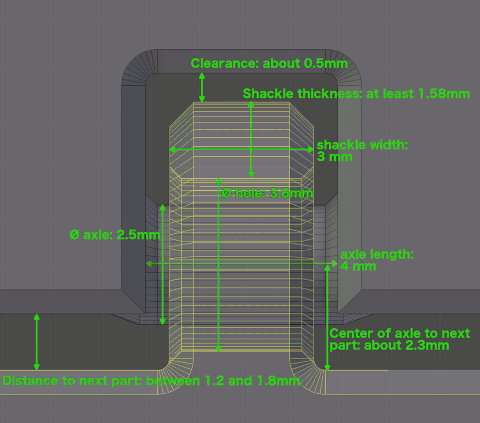
Hinge dimensions (🔎 view larger image)
dinosaur, flexible, print_in_place, t-rex, toy, Tyrannosaurus_Rex
